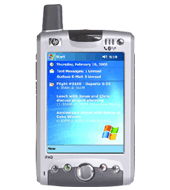|
Between Bluetooth and IRDA
1. Basically, IRDA employs infrared-wave to transfer signals, while Bluetooth radio frequency(RF). In transmission, IRDA requires ^line-of-sight ̄, namely, devices can¨t be hindered by any untransparent obstacles, for a simple reason that IRDA can only run a straight line and can easily be stopped even by several pieces of paper. Another shortcoming is that IRDA is effective only within 1-2 metres also due to its regorious requirement in transmission. However, the wavelength of RF is much greater than IRDA, hence better performance in bypassing. Bluetooth technique can make a connection within 10 metres with or without obstacles;
Because of the same reason, there is a characteristics which cannot be judged to be advantage or disadvantage. Two IRDA Devices can only be connected when they are fixed and face to face, cannot in process. Hence this technique only allows two devices connected at once. But Bluetooth can support multi-connection up to 8 different Bluetooth devices anywhere within 10m. Obviouly this convenience can on the other hand cause safty problem.
2. Just because of the same inviting characteristics of RF, Bluetooth devices suffer more interference from undesired Bluetooth devices as well as other wireless devices, 802.11b and zigbee for example, which are also transmitting in the frequency of 2.4Gb;
3. IRDA is now broadly used in household equipment and hand-hold devices, more popular than Bluetooth. The reason is mainly based on its relatively cheaper expenses. To make things worse, many OS (Operation System) such as Windows and Palm, basing on the same reason, choose IRDA as their wireless communication strategy, embedding quantities of IRDAs in their products, which also promotes its spread;
4. Previously, IRDA¨s transferring rate is merely 115.2Kb/s, in comparison, over which Bluetooth has a great advantage with its rate 1Mb/s. Recently, IRDA has been greatly improved to 4Mb/s, 16Mb/s lagging Bluetooth far behind. Fortunately, Bluetooth also has room to be improved. Some new techniques and new protocols concerned with the transmission rate are being discussed now;
5. A more fatal weakness is that Bluetooth consumes relatively more power than other wireless devices, which is badly needed to be improved.
Between Bluetooth and 802.11b
Another wireless technique is 802.11b with another name WiFi, which emerges from industrial standard, now extended for civil use.
1. In power consuming, though beaten by IRDA, Bluetooth is superior to 802.11b, anyhow. But it isn't desired to show it off, for Bluetooth is aimed at smart and handhold devices to transmit a little quantity of data, while 802.11b is designed to transmit large quantities of data, even ambitiously to take place of cables.
2. Bluetooth is portable and personal and consequently entertainment is important. Bluetooth can for this reason transfer multimedia data, say, video and audio.On the contrary, WiFi isn¨t good at it.
3. WiFi¨ transmission rate is typically 11Mb/s and coverage extended typically to 100M, and Bluetooth 10Mb/s to maximal 10M and it can hardly reach its extreme.
To impress readers a clearer presentation, the Table below would be helpful:
|
Bluetooth |
HomeRF |
802.11/WiFi |
IRDA |
Technique |
RF |
RF |
RF |
Infrared-Ray |
Main usage |
To replace cable |
Home or office WAN |
Company or campus WAN |
To replace cable |
Max rate |
1Mb/s |
10Mb/s |
11Mb/s |
4Mb/s |
Coverage (radius) |
10M |
50M |
60M |
1M |
Coverage (angle) |
360 centidegrees |
360 centidegrees |
360 centidegrees |
30 centidegrees |
Multimedia Support |
Yes |
Yes |
No |
Yes |
Spectrum Spread |
FHSS (Frequency hopping Spread Spectrum) |
FHSS |
DSSS (Direct Sequence Spread Spectrum) |
|
Capability of sustaining RF interference |
Medium |
Medium |
High |
No RF interference |
Power Consumption |
Relatively low |
High |
High |
Low |
Cost |
15 dollars |
70 dollars |
150 dollars |
2 dollars or less |
|
Still by now, WiFi, IRDA, Bluetooth as well as other wireless technique are still living under the same roof, and in the near future, the situation will won¨t be changed. They will still be competing with each other neck by neck for more consumers. Many companies are trying to combine all these techniques together, and some have to integrate these all. The following piture shows a mobile by HP, integrating all the three techniques above.
|
 |
Top |